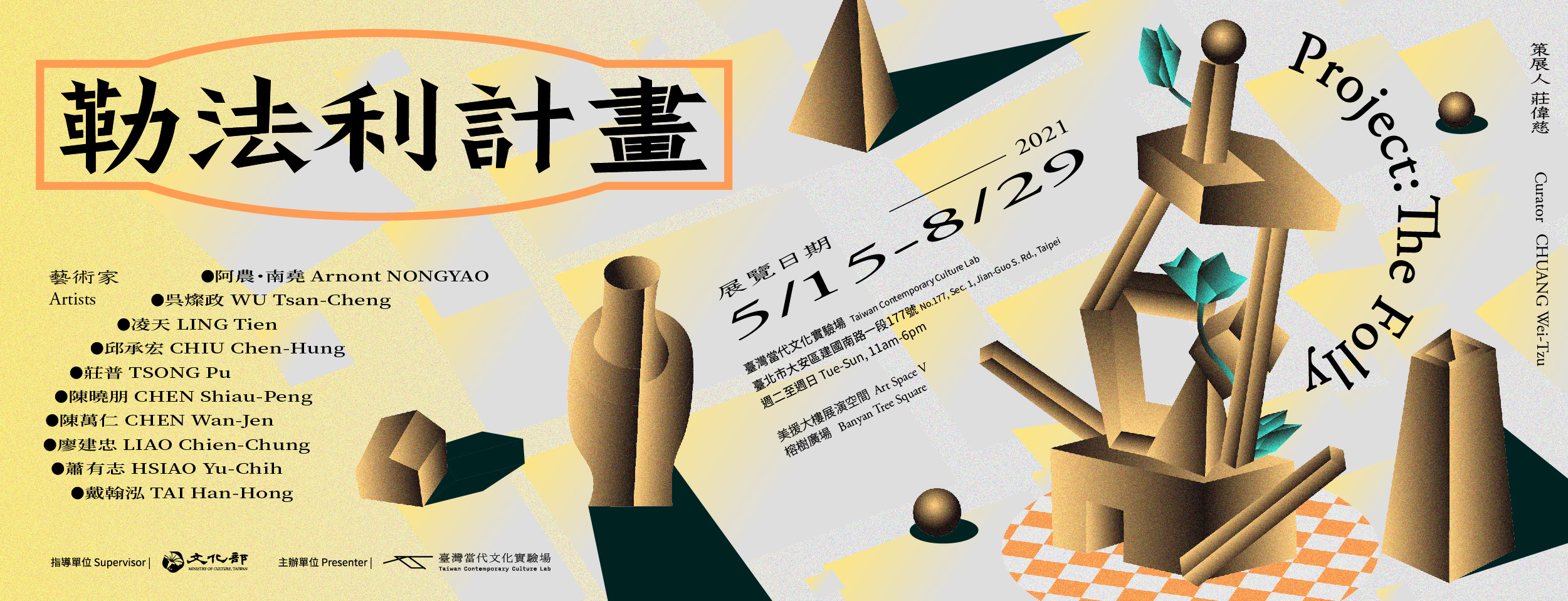The exhibition Project: The Folly opens in Art Space V and Banyan Tree Square of the Taiwan Contemporary Culture Lab (C-LAB). For the exhibition, C-LAB curator CHUANG Wei-Tzu invited 10 artists to propose art and architectural projects in an attempt to re-explore the relationships among people, spaces and city, within the former Air Force Command Headquarters, now a park with vast historical and urban development implications.
In the architectural field, the term “folly” initially meant buildings constructed for decoration instead of practical purpose, which comes from the French word “folie.” In the 1980s, architects in Europe and North America brought renewed attention and discussed the meaning of this type of structure. “Folly” became considered a structure not existing for a specific object, which is neither completely a building nor a sculpture. Therefore, “folly” means not only an architectural entity, but also a form with the connotation of openness for interpretation.
CHUANG says the exhibition ponders on the meaning of “place” based on the experimental concept implied by “folly.” “Place” here includes the location of the exhibition, namely Art Space V, and extensions of C-LAB’s location and site characteristics, which are starting points for thinking about the constructing of urban systems. From this point of view, the entire exhibition has been planned as a temporary “folly.” Artists have been invited to explore the relationships between people and spaces, as well as the connotations of places. Taiwanese artists HSIAO Yu-Chih, TSONG Pu, LIAO Chien-Chung, CHEN Shiau-Peng, LING Tien, TAI Han-Hong, CHIU Chen-Hung, CHEN Wan-Jen, and WU Tsan-Cheng and Thai artist Arnont NONGYAO respectively developed an artistic work or architectural project.
As the venues and spaces of the former Air Force Command Headquarters differ greatly from those of a fine arts museum, the exhibition encourages audiences to see and understand the site in new ways, with some of the works focusing on the dialogues with the space. It refers to the heterogeneity of the exhibition space and the historical, architectural, transport, and economic contexts of the location. CHEN Wan-Jen’s work, Redundant Tales, combines animation projection and scaffolding to explore the structure of the exhibition space. TAI Han-Hong presents a machinery-based work, From One Corner to the Other, as a metaphor for the establishment of tripartite relationships in an exhibition space through the artist, work, and audiences. CHIU Chen-Hung’s Plant Stand 05 was inspired by the changes taking place in C-LAB. Fragments of structures within the park were collected and integrated into a large sculpture, on which bitter vine (Mikania micrantha, also known as “green cancer”) was planted, referring to the historical changes and vacancies of the site. Continuing his creative methodology of “fakeology,” LIAO Chien-Chung builds CLABBUCKS, a wooden installation that resembles a coffee shop. Its interesting name is central to the artist’s question: Why is there an inseparable relationship between cultural sites and the consumption of coffee?
An attempt is made to explore the broad definition of “place” for understanding the existing systems in a city and the textures and compositions of spaces. In Park, WU Tsan-Cheng presents sounds collected in parks, from the songs of early residents to more recent chats among migrant workers, presenting transformations of a city against the backdrop of time and space. In 2019, Arnont NONGYAO produced Opera of Kard (Market) for the Singapore Biennale. For this exhibition, he created a new version, Opera of Kard 2, with sounds collected from 12 markets in the Chiang Mai area to form a music movement based on markets and everyday life.
Project Taichung by LING Tien is a series of observations of Taichung in terms of geography and architecture. Through data collection and visualization, Project Taichung reveals ordinary states that we may ignore. CHEN Shiau-Peng’s work provides a microscopic and private perspective of an artist living in Taipei. Through paintings, she presents her daily routine and discusses the subtle political nature hidden in maps and our lives. TSONG Pu’s large-scale installation, The Critical Dwelling, incorporates doors and windows from Huanmin New Village on Toad Mountain in Taipei’s Gongguan area as fragments of a once existing community, representing the traces of former dwellings. The reappearance of the objects in the former Air Force Command Headquarters is also a testament to historical changes and the fractured state of urban settlements. HSIAO Yu-Chih’s Cupboard House is an outdoor display. In contrast with the surrounding buildings, it is “the smallest surviving unit.” For many years, HSIAO has focused on the Mega-weave platform. As such, Cupboard House has been endowed with a new identity as a physical platform for the exchanges of second-hand exhibition resources, presenting concepts related to the realization of a digital community platform.
Project: The Folly attempts to obtain new viewpoints on the depiction of life in the present by the reversal of relationships and changing of perspectives through the intervention of architectural and art projects. The exhibition explores the nature of spaces and aims to find out a new way beyond utilitarianism and urban design concepts through structural metaphors and the transformation of the relationships between people and spaces. Once we are free from pragmatism and intervene the spaces with art, how will we gain a renewed understanding of the relationships among places, spaces, and urban development?
